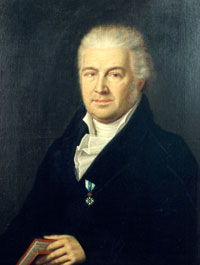Samuel Thomas von Sömmerring
| Samuel Thomas von Sömmerring | |
|---|---|

Portrait by Wendelin Moosbrugger
|
|
| Born | 28 January 1755 Thorn, Royal Prussia (now Toruń, Poland) |
| Died |
2 March 1830 (aged 75) Frankfurt am Main |
| Nationality | German |
| Fields | medicine |
| Alma mater | University of Göttingen |
| Doctoral advisor | Ernst Gottfried Baldinger |
Samuel Thomas von Sömmerring (28 January 1755 – 2 March 1830) was a German physician, anatomist, anthropologist, paleontologist and inventor. Sömmerring discovered the macula in the retina of the human eye. His investigations on the brain and the nervous system, on the sensory organs, on the embryo and its malformations, on the structure of the lungs, etc., made him one of the most important German anatomists.
Sömmerring was born in Thorn, Royal Prussia (Toruń, Poland) as the ninth child of the physician Johann Thomas Sömmerring. In 1774 he completed his education in Thorn and began to study medicine at the University of Göttingen. He visited Petrus Camper lecturing at the University in Franeker. He became a professor of anatomy at the Collegium Carolinum (housed in the Ottoneum, now a Natural History Museum) in Kassel and, beginning in 1784, at the University of Mainz. There he was for five years the dean of the medical faculty. Due to the fact that Mainz became part of the French Republic under the French Directory, Sömmerring opened up a practice in Frankfurt in 1795. As one of his many important enterprises, Sömmerring introduced against many resistances the vaccination against smallpox and became one of the first members of the Senckenbergische Naturforschende Gesellschaft and was nominated as counselor. He received offers of employment by the University of Jena and the University of St. Petersburg, but accepted in 1804 an invitation from the Academy of Science of Bavaria, in Munich. In this city, he became counselor to the court and was led into the Bavarian nobility.
...
Wikipedia
